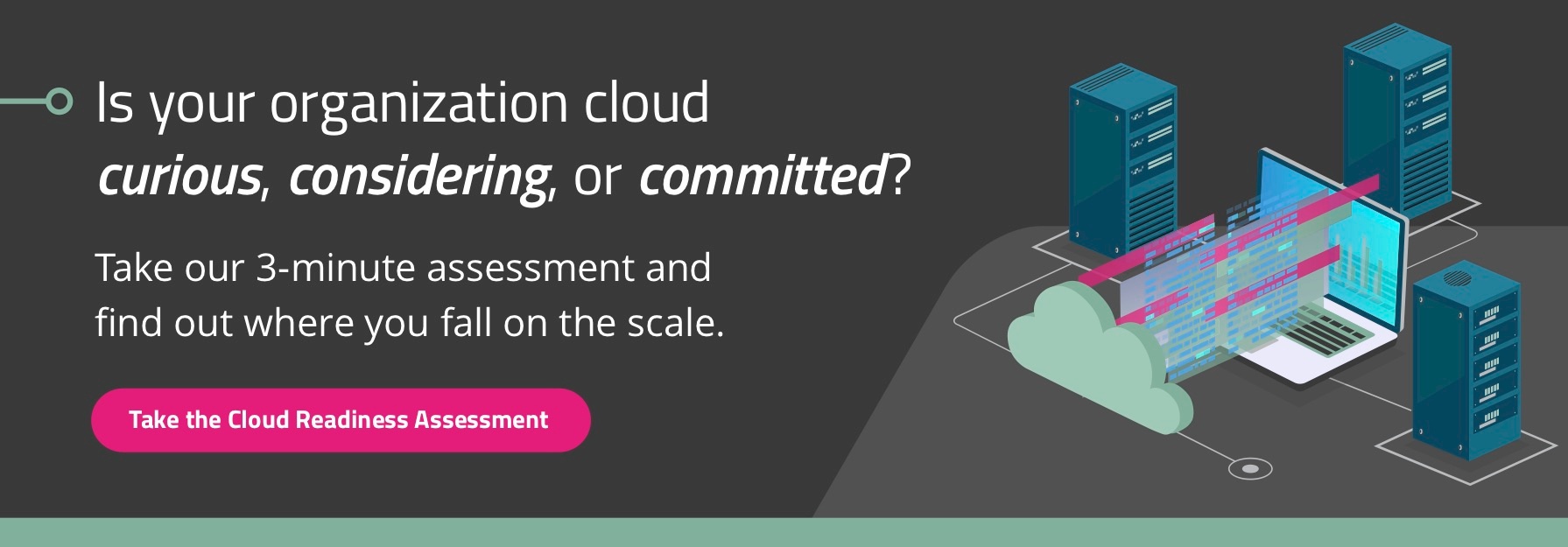-1.png?width=1160&name=Untitled%20design%20(3)-1.png) When an organization transitions to the cloud, the process is often viewed as an IT function, and while the transition and management of the cloud adoption falls under the purview of IT, it ultimately impacts an entire organization. Transitioning from an on-premise infrastructure to the cloud affects every department and requires the buy-in of everyone for it to be successful.
When an organization transitions to the cloud, the process is often viewed as an IT function, and while the transition and management of the cloud adoption falls under the purview of IT, it ultimately impacts an entire organization. Transitioning from an on-premise infrastructure to the cloud affects every department and requires the buy-in of everyone for it to be successful.
Understanding the value of the cloud
We often say that the tech is the easy part – it’s the required culture change that is the challenge. Organizations that successfully transition to the cloud have developed strategies, plans and training that are inclusive of all teams so that all employees feel comfortable, secure and more productive
According to an article in Forbes, “While aspects around the speed, flexibility, scalability and agility that cloud provides can be measured, cloud also enables innovation due to these inherent features. Innovation as a process cannot be quantified. However, it can be a significant competitive advantage for organizations and can even lead to market disruption and, thereby, immense tangible value.”
One of the most important areas of focus outside of IT is Finance. Demonstrating value and managing the costs of the cloud are critical to ensuring that an organization is optimizing the transition.
Here are a few considerations to think about when determining the value of the cloud.
- Define ROI: The organization needs to identify the value it wants to achieve, and build a business case around it. Forbes shares that a strong business case would mean a lower total cost of ownership (TCO) when factoring in the capital costs, real-time operating costs, opportunity costs around downtime, productivity benefits or losses, training and communication costs, etc.
- Readiness and Cost of Opportunity: Digital transformation is key to credit unions improving their competitive advantage. Recognizing that cloud adoption can help an organization become future ready to navigate crises as well as the ability to enable quicker data-driven decision-making to drive better business is key to leadership buy-in to the digital transformation journey.
- Adopting the mindset that technology is an asset, not a cost center, is an important component of the organizational cultural transition. Reducing response time and increasing speed to deliver new apps will help reduce risk and improve the customer experience.
- Financial Process: According to AWS, 35% of an organization’s capital is wasted by the mismanagement of the cloud. AWS shares that “The discipline of making costs visible and then managing them as a business imperative rather than as an IT activity is part of the culture change necessary for newly digitized organizations.”
Migration to the cloud means a transition in the financial process and budgeting for IT. No longer do you estimate the costs of new infrastructure and build it into the budget as a one-time cost that is forgotten when it’s been installed.
AWS suggests the following principles for adapting a more predictable model:- Aggregate your organization's Amazon Web Services accounts using AWS Organizations for a single, company-wide view of spend
- Conscientiously tag every service used for cost reporting, including owner, stack type (test, prod, etc), and associated application
- Determine your internal cost allocation model
- Create and evolve actionable reporting
- Comparing IT Costs: Compare the cost of achieving business objectives with on-prem infrastructure and cloud. Compare the cost for one, three and five years. Start by comparing basic day-to-day costs. Consider secondary on-prem factors like hardware, software apps, managed services, cybersecurity, real estate, and future capacity, maintenance, downtime, staff deployment, training electricity/cooling etc.
- IT Agility: Consider how the cloud can turn IT into an asset to support growth and agility.
- Quickly deploy new compute/network/storage solutions
- Manage unplanned downtime
- High software quality
- Staff productivity & training
- Member Experience: Ability to focus on innovation vs. IT maintenance to deliver new applications and updated software which enhances member value and increases the member experience.
- Cybersecurity: Build the highest standards for privacy and data security with the cloud. Reduce human errors through automation tasks allowing your team to focus on business tasks. Reduce risk and meet compliance standards simultaneously.
Cost management in the cloud can be daunting at first, but once you weigh the options, develop a process and adopt a culture that supports technology, the results are lucrative. Understanding the value allows for a more efficient, secure and cost effective way to manage your organization, remain competitive and delight your members now and into the future.
With measurable goals and an understanding of associated costs, organizational leaders can now have greater control and a level of education to make appropriate business decisions.
About the Author

Zach Hill, CTO
Zach began his career early in life with an internship as a helpdesk technician at a recycling company out of Chicago and has worked his way through the IT ranks from System Administrator to his current role as Chief Technology Officer at Think|Stack. His specialties come from a heavy networking engineering and virtualization background allowing him to easily transition into the dynamic and complex cloud environments of the modern technical landscape. As an AWS Certified Solutions Architect – Professional, Zach is equally at home generating the architectural plans for a complex service deployment within AWS. Zach’s vision and drive to be at the bleeding-edge fuels Think|Stack’s growth and provides clients with an innovative, constantly evolving technology strategy.



.jpg)

.jpg)
